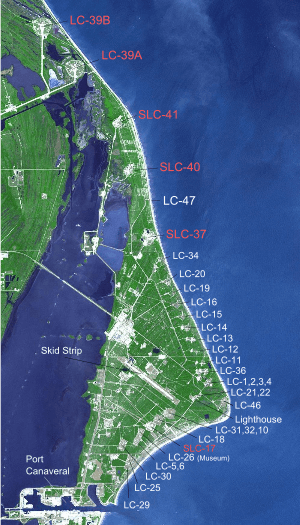Cape Canaveral Air Force Station Launch Complex 2
 Map of launch complexes at Cape Canaveral Air Force Station. LC2 is located at the farthest point East on the map. | |||||||||||
| Launch site | Cape Canaveral Air Force Station | ||||||||||
|---|---|---|---|---|---|---|---|---|---|---|---|
| Location | 28°27′56″N 80°32′13″W / 28.46556°N 80.53694°WCoordinates: 28°27′56″N 80°32′13″W / 28.46556°N 80.53694°W | ||||||||||
| Short name | LC-2 | ||||||||||
| Operator | United States Air Force | ||||||||||
| Total launches | 15 | ||||||||||
| Launch pad(s) | 1 | ||||||||||
| Min / max orbital inclination | 28° - 57° | ||||||||||
| |||||||||||
Launch Complex 2 (LC-2) is a deactivated US Air Force launch site on the eastern tip of Cape Canaveral, Florida at Cape Canaveral Air Force Station. It was constructed with launch complexes 1, 3, and 4, in the early 1950s, for the Snark missile program.[1]
The first launch from this site was a Snark test conducted on February 18, 1954. The complex was used for Snark missions until 1960, and then was utilized as a helicopter pad during Project Mercury. The final use of the site was during the 1980s for tethered aerostat balloon radar missions.[2]
References
- ↑ Svirskas, Rob (September 14, 2008). "Complexes 1-4". Cape Canaveral Air Force Station Virtual Tour. Retrieved January 25, 2010.
- ↑ Pike, John (April 27, 2005). "Complexes 1 & 2 -- Cape Canaveral Air Station". GlobalSecurity.org. GlobalSecurity.org. Retrieved January 25, 2010.
External links
This article is issued from Wikipedia - version of the 12/27/2015. The text is available under the Creative Commons Attribution/Share Alike but additional terms may apply for the media files.